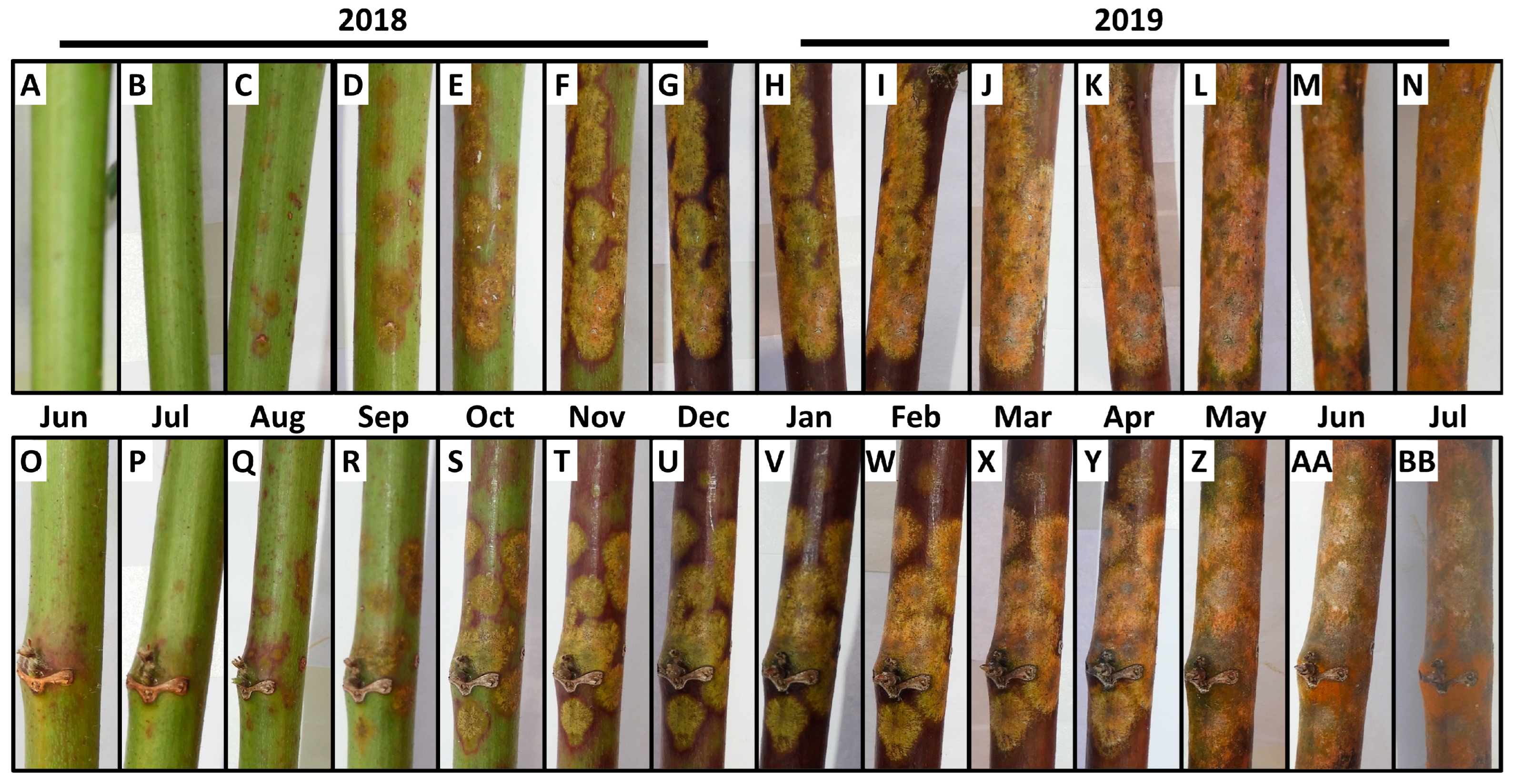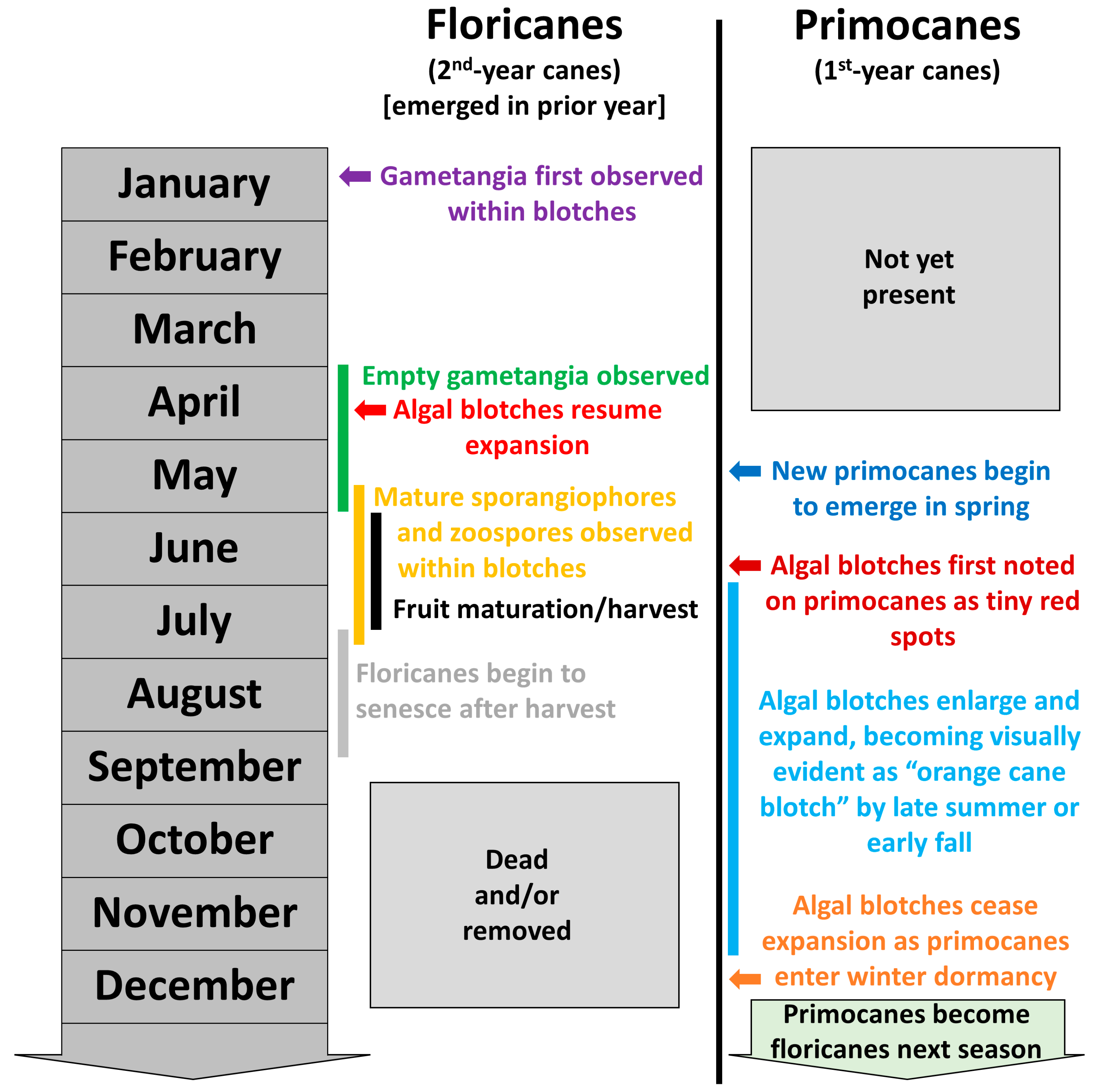Distinctive Features of the Orange Cane Blotch Disease Cycle on Commercial Blackberry (Rubus fructicosis)
Abstract
1. Introduction
2. Materials and Methods
2.1. Commercial Field Sites
2.2. Confirmation of Causal Organism
2.3. Photographic Observation of Diseased Canes
2.4. Microscopy of Diseased Tissue
3. Results
3.1. Confirmation of Causal Organism
3.2. Photographic Observation of Diseased Canes
3.3. Microscopy of Diseased Tissue
3.4. Observational Timeline
4. Discussion
5. Conclusions
Supplementary Materials
Author Contributions
Funding
Data Availability Statement
Acknowledgments
Conflicts of Interest
References
- Brannen, P. Orange Felt (Orange Cane Blotch) of Blackberry. Available online: https://extension.uga.edu/publications/detail.html?number=C892 (accessed on 17 March 2023).
- Brooks, F.E. Plant-parasitic algae (Chlorophyta: Trentepohliales) in American Samoa. Pac. Sci. 2004, 58, 419–428. [Google Scholar] [CrossRef]
- Nelson, S. Cephaleuros Species, the Plant-Parasitic Algae. Available online: https://www.ctahr.hawaii.edu/oc/freepubs/pdf/pd-43.pdf (accessed on 17 March 2023).
- Holcomb, G.E.; Vann, S.R.; Buckley, J.B. First report of Cephaleuros virescens in Arkansas and its occurrence on cultivated blackberry in Arkansas and Louisiana. Plant Dis. 1998, 82, 263. [Google Scholar] [CrossRef] [PubMed]
- Browne, F.B.; Brannen, P.M.; Scherm, H.; Brewer, M.T.; Wilde, S.B.; Richardson, E.A. Orange cane blotch of commercial blackberry in the southeastern United States. Plant Health Prog. 2019, 20, 67–69. [Google Scholar] [CrossRef]
- Browne, F.B.; Brannen, P.M.; Scherm, H.; Richardson, E.A.; Taylor, J.R. Yield response to orange cane blotch of blackberry grown in the Georgia coastal plain. Plant Dis. 2020, 104, 161–167. [Google Scholar] [CrossRef] [PubMed]
- Browne, F.B.; Brannen, P.M.; Scherm, H.; Taylor, J.R.; Shealey, J.S.; Fall, L.A.; Beasley, E.D. Evaluation of disinfectants, algicides, and fungicides for control of orange cane blotch of blackberry in the field. Crop Prot. 2019, 122, 112–117. [Google Scholar] [CrossRef]
- Chapman, R.L.; Good, B.H. Subaerial symbiotic green algae: Interactions with vascular plant hosts [Phycopeltis, Stomatochroon, Trentepohlia]. In Algal Symbiosis: A Continuum of Interaction Strategies; Cambridge University Press: Cambridge, UK, 1983; pp. 173–204. [Google Scholar]
- Browne, F.B. Orange Cane Blotch of Blackberry Caused by Cephaleuros virescens: Chemical Control and Yield Losses Associated with the Disease. Master’s Thesis, University of Georgia, Athens, GA, USA, 2017. [Google Scholar]
- Chapman, R.L. Ultrastructure of Cephaleuros virescens (Chroolepidaceae-Chlorophyta). 1. Scanning electron-microscopy of zoosporangia. Am. J. Bot. 1976, 63, 1060–1070. [Google Scholar] [CrossRef]
- Suto, Y.; Ohtani, S. Morphology and taxonomy of five Cephaleuros species (Trentepohliaceae, Chlorophyta) from Japan, including three new species. Phycologia 2009, 48, 213–236. [Google Scholar] [CrossRef]
- Brooks, F.E.; Rindi, F.; Suto, Y.; Ohtani, S.; Green, M. The Trentepohliales (Ulvophyceae, Chlorophyta): An unusual algal order and its novel plant pathogen—Cephaleuros. Plant Dis. 2015, 99, 740–753. [Google Scholar] [CrossRef] [PubMed]
- Suto, Y.; Ohtani, S. Seasonal development of five Cephaleuros species (Trentepohliaceae, Chlorophyta) on the leaves of woody plants and the behaviors of their gametes and zoospores. Phycol. Res. 2013, 61, 105–115. [Google Scholar] [CrossRef]
- Suto, Y.; Ohtani, S. Morphological features and chromosome numbers in cultures of five Cephaleuros species (Trentepohliaceae, Chlorophyta) from Japan. Phycol. Res. 2010, 59, 42–51. [Google Scholar] [CrossRef]
- Hamby, R.K.; Sims, L.; Issel, L.; Zimmer, E. Direct ribosomal RNA sequencing: Optimization of extraction and sequencing methods for work with higher plants. Plant Mol. Biol. Rep. 1988, 6, 175–192. [Google Scholar] [CrossRef]
- Medin, L.; Elwood, H.J.; Stickel, S.; Sogin, M.L. The characterization of enzymatically amplified eukaryotic 16s-like rRNA-coding regions. Gene 1988, 71, 491–499. [Google Scholar] [CrossRef]
- Rindi, F.; Lam, D.W.; Lopez-Bautista, J.M. Phylogenetic relationships and species circumscription in Trentepohlia and Printzina (Trentepohliales, Chlorophyta). Mol. Phylogenetics Evol. 2009, 52, 329–339. [Google Scholar] [CrossRef] [PubMed]
- Chapman, R.L. Ultrastructure of Cephaleuros-virescens (Chroolepidaceae, Chlorophyta). 2. Gametes. Am. J. Bot. 1980, 67, 10–17. [Google Scholar] [CrossRef]
- Rindi, F.; Guiry, M.D. Diversity, life history, and ecology of Trentepohlia and Printzina (trentepohliales, chlorophyta) in urban habitats in Western Ireland. J. Phycol. 2002, 38, 39–54. [Google Scholar] [CrossRef]
- Spolti, P.; Valdebenito-Sanhueza, R.M.; Campos, Â.D.; del Ponte, E. Mode of action of potassium phosphite on bull’s eye rot of apple. Summa Phytopathol. 2015, 41, 42–48. [Google Scholar] [CrossRef]



Disclaimer/Publisher’s Note: The statements, opinions and data contained in all publications are solely those of the individual author(s) and contributor(s) and not of MDPI and/or the editor(s). MDPI and/or the editor(s) disclaim responsibility for any injury to people or property resulting from any ideas, methods, instructions or products referred to in the content. |
© 2023 by the authors. Licensee MDPI, Basel, Switzerland. This article is an open access article distributed under the terms and conditions of the Creative Commons Attribution (CC BY) license (https://creativecommons.org/licenses/by/4.0/).
Share and Cite
Hemphill, W.H.; Brannen, P.M.; Richardson, E.A.; Oliver, J.E. Distinctive Features of the Orange Cane Blotch Disease Cycle on Commercial Blackberry (Rubus fructicosis). Horticulturae 2023, 9, 565. https://doi.org/10.3390/horticulturae9050565
Hemphill WH, Brannen PM, Richardson EA, Oliver JE. Distinctive Features of the Orange Cane Blotch Disease Cycle on Commercial Blackberry (Rubus fructicosis). Horticulturae. 2023; 9(5):565. https://doi.org/10.3390/horticulturae9050565
Chicago/Turabian StyleHemphill, Will H., Phillip M. Brannen, Elizabeth A. Richardson, and Jonathan E. Oliver. 2023. "Distinctive Features of the Orange Cane Blotch Disease Cycle on Commercial Blackberry (Rubus fructicosis)" Horticulturae 9, no. 5: 565. https://doi.org/10.3390/horticulturae9050565
APA StyleHemphill, W. H., Brannen, P. M., Richardson, E. A., & Oliver, J. E. (2023). Distinctive Features of the Orange Cane Blotch Disease Cycle on Commercial Blackberry (Rubus fructicosis). Horticulturae, 9(5), 565. https://doi.org/10.3390/horticulturae9050565





